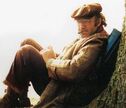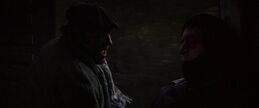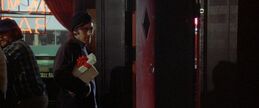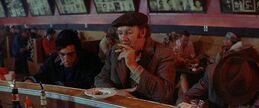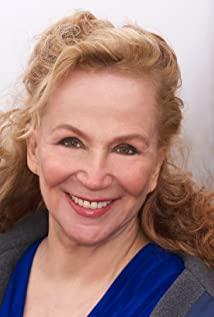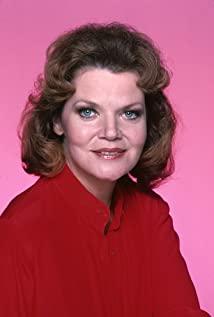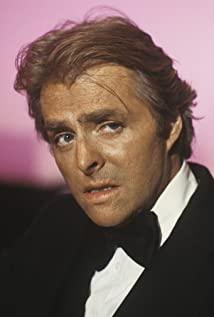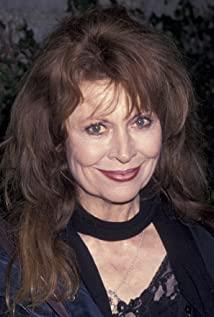opening scene of the movie Max (played by Gene Hackman), walks from a distance, the background is a bare yellow mound in the desert, with a few dry land. The trees are green on the top of the hill. The camera was silent at him until he walked to the wire fence in the middle shot. Max threw the briefcase over the fence first, then bent down and tried to get out of the two barbed wire fences. The spikes of the wire hooked his collar. He pulled off his clothes abruptly, stepped out of his right leg, and then probed. Get out of the upper body, and finally pull out the left leg. He picked up the briefcase, stood up straight, paused, and looked into the distance. This is a long shot taken with a fixed camera, showing the observation angle of another male protagonist: the shot is cut to Lion (played by Al Pacino), who is observing Max from between the forks of a big tree. Lion’s appearance shot was extremely short, and the shot quickly switched back to Max. He looked into the distance and walked in the direction of the camera, without paying attention to his feet, stepping on the side of the soil slope and sliding onto the road. This was followed by Lion's slight smile between the tree forks. The two men met on a section of the highway in the desert of the Midwestern United States. The straight highway stretched out to distant mountains. It was noon, the sun was strong, gray clouds obscured the sun, and the wind was blowing. The strong wind rolled the dead branches into a big ball and rolled past Max. Then another ball of dead branches rolled over Lion’s calf and rolled to the opposite side of the road. . An interesting symbol.
The story of the two men has since been narrated in a straight line. When they first met Max was almost hostile to Lion, but after the two had a ride on the same night, Lion won Max's favor and trust. They got out of the car in the golden sun in the early morning and walked into a tavern. The scene is simple and refined: through the conversation between the two, the two people explained their origins and whereabouts. Max has just served his six-year sentence and is about to go to Pittsburgh to take out the money he has accumulated in the bank for many years and open a car wash in the local area. Lion has been a sailor for 5 years and is going back to Detroit to visit his wife and five-year-old child. Max invited Lion to join him in a car wash business. The two hit it off and decided to go on the same road. They first settled in Denver to visit Max's sister Kelly, then went to Detroit to fulfill Lion's wish, and finally went to Pittsburgh to start the car wash business. An important prop is explained in this scene: a white gift box with a red silk flower knot on the lid, and inside it is a children's desk lamp—a gift that Lion prepared for his five-year-old child. He has not contacted his family for many years or even knew the gender of the child, so he chose this gift for boys and girls. This box is not only a symbol but also an important emotional sustenance. It goes with Lion toss and turns until it becomes the finishing touch in the ending tragic plot.
The latter play is slightly dull due to lack of plot. The two went through twists and turns and came to Max’s sister Kaili’s house as planned. She and a friend named Frankie are in a waste recycling business. The four chatted and drank together and had a good time, until Max fought for Frankie in the tavern and Lion helped, and the two were sent to the Probation Farm in Denver. This scene depicts the character and leisure life of the middle and lower classes through Kelly, Frankie and the group photos in the public tavern. They are simple-minded, outspoken, kind, optimistic, happy and contented easily. They drank and danced in the tavern, making vulgar jokes. In one scene, Max lit a trash can outside the tavern to make a bonfire. People gushing from the tavern, sang and danced around the bonfire. It was very infectious. The director used a neutral and restrained presentation technique to give the film a simple atmosphere that is easy to generate sympathy.
Regarding the theme of the scarecrow, there is an overly explicit explanation in the movie. American film critic Roger Ebert criticized this problem for superfluous, and even used the following story to reinforce the problem. He believes that restraint will be better. The scarecrow originated from Lion asking Max if the crow was afraid of the scarecrow. Lion thought that crows were not afraid of scarecrows. Scarecrows made them laugh. When they were happy, they decided not to harass the farmer's rice fields. This explanation and Lion's seriousness made Max feel stupid and ridiculous. Of course, this question is only used to point out Lion's philosophy of dealing with things: use kindness and smile to solve problems and conflicts. This is by no means a spiritual motto, but an outright philosophy of the weak. It is an excuse for Lion to reject the code of conduct in the adult world. It is his self-deception method to protect himself by avoiding it, just like he abandoned his pregnant wife five years ago. To the sea. He is still a boy psychologically. He is in sharp contrast with Max: Max is tall and strong, with a tough attitude, and uses his fists to survive in a cruel society. Lion feels somewhat dependent on Max. He cherishes Max, loves him, and fears that he will lose him due to violence. When Max and Lion met in the tavern, he told Lion that he didn't believe in anyone, and he didn't love anyone. He defended himself with preemptive rudeness and toughness. He may have seen in Lion the traits he has lost that are useless for survival: innocence, kindness, trust, and vulnerability. He was moved by this man who refused to grow up. Two lonely people face the same problem after being isolated for many years (Lion was at sea for 5 years and Max was in jail for 6 years): re-adaptation to a society that has changed a lot and survive, and it is better to have a partner than to be alone. So during the journey, the two depended on each other, their hearts were warm, and they plucked up courage and confidence in life. With this level of affection, he can experience the warmth of laughter with tears in the comical section of Max turning his anger into a striptease show in the tavern. At that time, Max and Lion had just come out of the probation farm. Lion was nearly raped by a man named Jack on the farm. During the resistance, he was beaten to blood. Max taught Jack with his fists. It’s unknown whether Lion’s heart has changed, but in the tavern scene, Max dances a funny striptease in order to keep and please Lion, who wants to leave because of his anger. There is a subtle change in Max’s expression: he starts. Shi also cooperated with Max to sing a dance song and laughed with everyone, but as Max jumped higher and higher and became more and more ridiculous, his smile dimmed, the light in his eyes dimmed, and a layer of faint Frustration enveloped his face. Does this subtle change in expression mean a certain change in Lion's heart? What is it again? Quite mysterious.
At the end of the film, Max accompanied Lion to the neighborhood where Lion's wife lived in Detroit. The color of the film has changed from the bright and warm golden color to the cool blue and gray color. It is not only the change of geography and climate, but also the special rendering of the atmosphere, which foreshadows the tragedy in the future. Lion went to his wife's door and changed his mind, and decided to call his wife first. During the phone call, Lion learned that his wife Annie had remarried, and Annie then lied on the phone and made Lion's minds completely disheartened. Lion hung up the phone dumbly. The audience knows everything, but Max, who is waiting outside the phone booth, knows nothing. Lion calmed down and slowly opened the folding door of the phone booth. He suddenly jumped at Max and cheered that his child was a boy. It was great. They were doing well and he didn't want to disturb them. Lion happily hooked Max's shoulders and proposed to go to Fountain Square, revisiting the places he and Annie had often visited. The white gift box was forgotten on the trunk lid of a roadside car. The lens gave it a close-up: After Dianpei was tossed around, the body of the box was dirty and the four corners of the lid had been cracked. Lion's courage and hope to assume responsibility like an adult man was frustrated by reality and discarded like that gift box. At this time, sorrow was accumulated in Lion's heart with a strong smile, and it was also blocked in the audience's throat, suppressed and waiting to erupt. The scene in the fountain square uses a joyous atmosphere to refer back to sadness, which makes the tension of tragedy reach its extreme value. The sadness of the audience was delayed and suppressed to the maximum, and it was not released until Lion finally collapsed. When the mood is brewing and transforming, the performance of the actors here is a challenge, and the young Al did a good job. The end of the film is open. I think it hints at some hope, or at least a kind of confidence to face and endure the hardships of life.
Gene Hackman can be said to be able to explain the profound things in a simple way in his performance, and his skill is very good. The shortcomings of Al Pacino's performance fit exactly with Lion's personality.
View more about Scarecrow reviews



